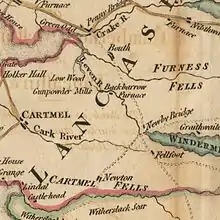Low Wood Gunpowder Works
Low Wood Gunpowder Works (also Lowwood) was a gunpowder mill founded in Furness, England, at the end of the 18th century. It became a significant supplier, and survived as a business until taken over by Imperial Chemical Industries around 1930. The works has been disused since 1935.[1]

The mill was set up on an estuary site, for sea access, on the River Leven. Initially it was called Daye Barker & Co., the founding partners being Daye Barker, James King, Christopher Wilson and Joseph Fayrer.[2] The surviving Clock Tower Works is a Grade II* Listed Building.[3]
Gunpowder production in the area (now southern Cumbria) had begun in 1764, with a mill at Sedgwick built by John Wakefield of Kendal. An important aspect was the supply of the triangular trade, in particular of Liverpool merchants engaged in it. The Low Wood works started to operate in 1798.[4][5]
Background
The Lowwood site, near Haverthwaite, had been used earlier for a forge of the 17th century, under the alternate name Burnbarrow (closed down by 1620).[6] In the 18th century Isaac Wilkinson set up a furnace for iron production.[7] A pre-existing weir may have been used by the forge.[8] Factors favouring gunpowder mill sites in what is now Cumbria included the existing charcoal industry and water power.[9]
Daye Barker left his cotton business at nearby Backbarrow in 1798.[10] Daye Barker & Co was issued a gunpowder licence on 2 October of that year.[11]
Early days
The mill made black powder, mixing imported sulphur and saltpetre with charcoal, which initially was made locally.[12] It adopted the suggestion of government adviser Richard Watson, to control the conditions under which charcoal was prepared, as charcoal cylinders, for greater reliability.[13] The large demand created for charcoal was met from coppices on Windermere, Coniston Water and Esthwaite Water.[14] The best woods from the point of view of powder grain size were juniper (local name "savin"), followed by alder and silver birch.[15]
The Leven was navigable nearly to Low Wood Bridge, which may have been erected by the company.[16][15] Fayrer, who died in 1801, was a former slaver captain, and was the company's agent in Liverpool, an important export market for gunpowder in particular to West Africa. He also was in charge of the import via Ulverston of raw materials. Wilson's uncle Thomas Parke operated there. Fayrer's role was taken over by the firm of Preston & Winder, with Gerrard Preston, a slaver captain and merchant from Lancaster.[17] He had died by 1804, his firm having been wound up at the start of 1803.[18][19]
Later years
After the Slave Trade Act 1807 the company switched largely to the manufacture of blasting powder, a market in which it became prominent.[20][2] Daye Barker died in 1835. He was replaced in the company by his son of the same name.[21]
A narrow gauge tramway was constructed for the mill.[22] The normal transportation arrangement was: to a store at Roudsea, then by sloop to Greenodd or Ulverston. The company had a magazine at Liscard in the Wirral, licensed under the Gunpowder Act 1772. A branch line to the Furness Railway was opened in 1869.[23] In the 1880s Bark Barn in Roudsea Wood near Haverthwaite may have been used as a store.[24] The safety record was poor, with explosions occurring to 1903.[25]
The younger Daye Barker left the partnership in 1858.[26] The Lowwood Company became a limited company in 1863.[21] It was taken over in 1882 by W. H. Wakefield & Co, who operated the Gatebeck Gunpowder Mills near Kendal.[27]
Notes
- English Heritage Risk Register, Lowwood Gunpowder Works, Haverthwaite, South Lakeland, Cumbria. Archived 2013-05-05 at archive.today
- TNA, Low Wood Gunpowder Works Summary List.
- britishlistedbuildings.co.uk, Clock Tower Works, Haverthwaite.
- Crocker 1988, p. 1
- Abraham Dent of Kirkby Stephen. Manchester University Press. 1970. p. 18. GGKEY:YU2C8FRTBK8. Retrieved 23 April 2013.
- Charles Murray Lowther Bouch; Gwilym Peredur Jones (1961). A Short Economic and Social History of the Lake Counties, 1500-1830. Manchester University Press. pp. 129–. GGKEY:JX07DREFTUF. Retrieved 14 April 2013.
- Harris, J. R. "Wilkinson, Isaac (bap. 1695, d. 1784)". Oxford Dictionary of National Biography (online ed.). Oxford University Press. doi:10.1093/ref:odnb/47483. (Subscription or UK public library membership required.)
- Historic England. "Lowwood gunpowder works (1018134)". National Heritage List for England. Retrieved 20 June 2017.
- Archer & Haley 2005, p. 82
- "No. 15130". The London Gazette. 4 May 1799. p. 429.
- Crocker 1988, p. 2
- Frank Duerden (1 March 2006). Best Walks In The Lake District. frances lincoln ltd. p. 100. ISBN 978-0-7112-2421-6. Retrieved 14 April 2013.
- Archer & Haley 2005, pp. 74–75
- Alan G. Crosby (2006). The North West. HarperCollins Publishers Limited. p. 117. ISBN 978-0-00-715577-4. Retrieved 14 April 2013.
- Frank Welsh (1997). The Companion Guide to the Lake District. Boydell & Brewer Ltd. p. 114. ISBN 978-1-900639-23-1. Retrieved 14 April 2013.
- britishlistedbuildings.co.uk, Low Wood Bridge.
- David Richardson; Anthony J. Tibbles; Suzanne Schwarz (2007). Liverpool and transatlantic slavery. Liverpool University Press. pp. 129–131. ISBN 978-1-84631-066-9. Retrieved 14 April 2013.
- "No. 15834". The London Gazette. 13 August 1805. p. 1042.
- "No. 15551". The London Gazette. 18 January 1803. p. 96.
- John Duncan Marshall; John K. Walton (1981). The Lake Counties from 1830 to the Mid-twentieth Century: A Study in Regional Change. Manchester University Press. p. 27. ISBN 978-0-7190-0824-5. Retrieved 14 April 2013.
- Crocker 1988, p. 3
- Gerald Nabarro; Gerald Nabarro (Sir.) (1972). Steam Nostalgia: Locomotive and Railway Preservation in Great Britain. Routledge & Kegan Paul, Limited. p. 157. ISBN 978-0-7100-7391-4. Retrieved 14 April 2013.
- Crocker 1988, p. 7
- english-heritage.org.uk, Bark Barn, Roudsea Wood, Haverthwaite, Cumbria.
- Crocker 1988, p. 6
- "No. 22162". The London Gazette. 16 July 1858. p. 3306.
- Edward Arthur Brayley Hodgetts, Tom Gregorie Tullock, The rise and progress of the British explosives industry (1909) pp. 415–6; archive.org.